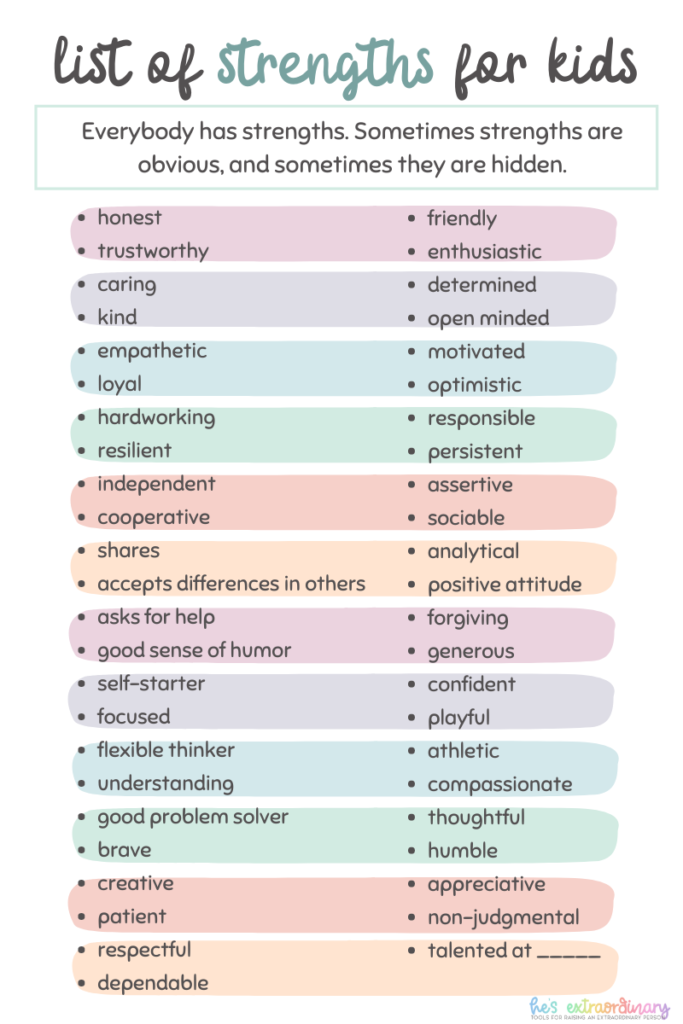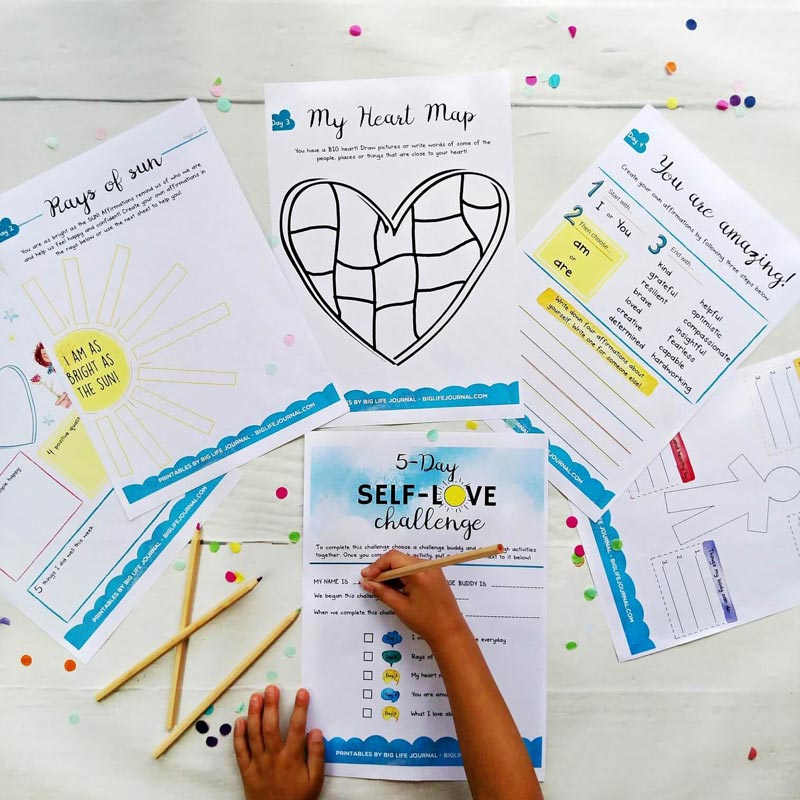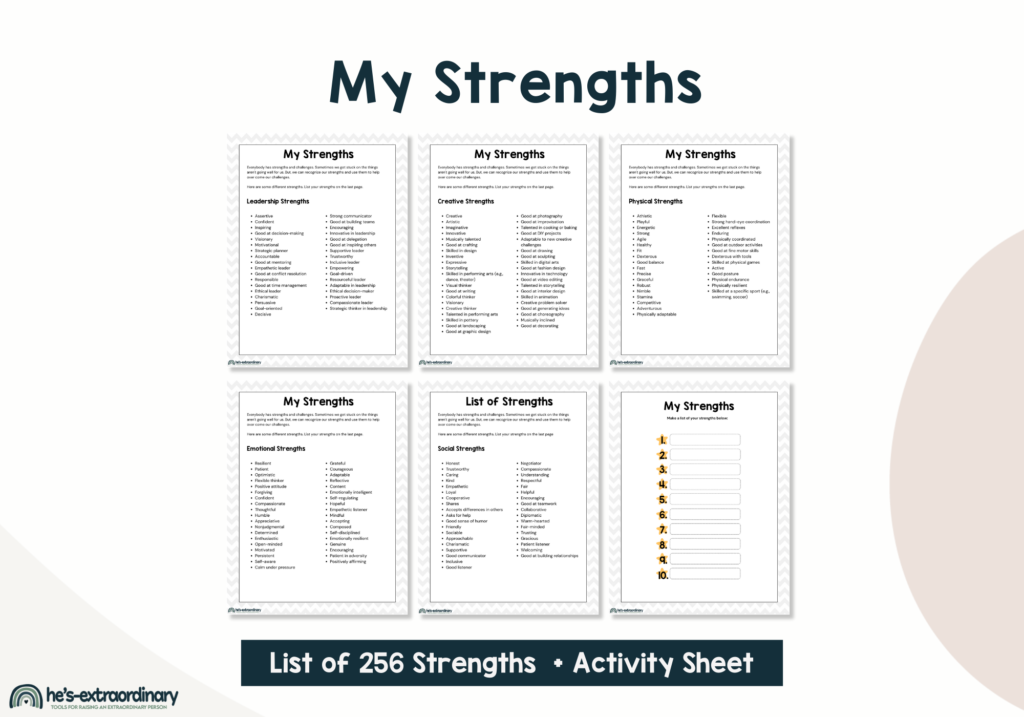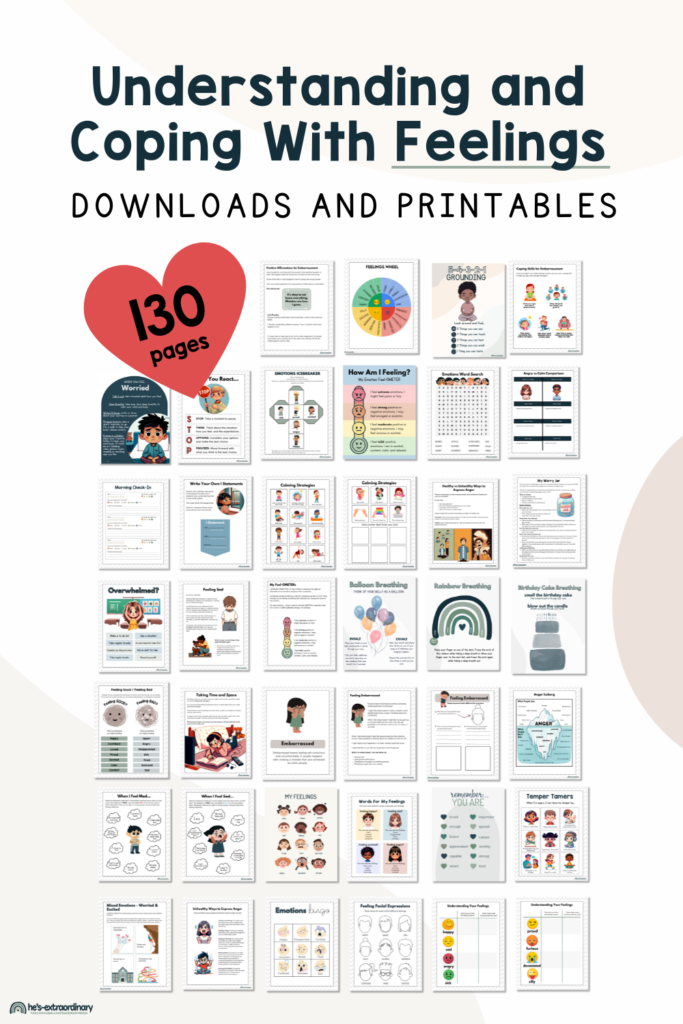How to Teach Your Child to Recognize Their Strengths [Includes List of 256 Strengths]
What’s inside this article: Tips for teaching your child about their strengths and how to identify them, which helps children build confidence and develop a growth mindset. Includes a printable list of strengths to use as a guide.
Disclaimer: This post contains affiliate links.
Everyone, no matter who you are, has strengths and challenges. Some strengths are easy to notice, and some are more subtle.
Helping your child identify their strengths is a great way to boost their self-esteem. With increased confidence, you can also coach your child on using their strengths to help overcome some of their challenges.
If your child has challenges that significantly impact their lives – such as anxiety, a learning disability, or a neurodivergence such as autism or ADHD – they may have a hard time seeing their strengths and may deal with low self-esteem.
Helping them see that everyone has challenges and strengths and knowing their strengths is essential for their self-esteem and mindset.
This article will teach you how to help your child learn about their strengths and how they can use those strengths in everyday life.
Teaching Your Child About Strengths
Start by explaining to your child that everyone has strengths and that there are many different kinds of strengths.
Sometimes, these strengths are obvious, like when someone excels at singing or playing a sport. However, strengths such as patience or acceptance of other people’s differences are often a bit harder for kids to recognize.
You can use this free printable list of strengths and the strengths activity sheet below to help you.
Types of Strengths
There are many different types of strengths that people can have.
Understanding these categories can make it easier for kids to see the full range of their capabilities and encourage them to appreciate strengths they might not have noticed.
Below are some common types of strengths:
- Social Strengths: These strengths help a person interact effectively with others. They include communication skills, empathy, and the ability to work well in teams.
- Emotional Strengths: These involve managing and understanding emotions. Resilience, patience, and optimism are examples of emotional strengths.
- Cognitive Strengths: These are related to thinking and learning. Creativity, problem-solving, and analytical thinking fall under this category.
- Character Strengths: These are traits that reflect a person’s core values—for example, honesty, kindness, and integrity.
- Physical Strengths: These are related to a person’s physical abilities, such as athleticism or hand-eye coordination.
- Creative Strengths: These involve using imagination and innovation, such as artistic talent, musical ability, and inventiveness.
- Leadership Strengths include the ability to lead and inspire others, make decisions, and take responsibility.
Child Strengths Examples
There are so many different strengths your child may have.
Here’s a list of examples to help you get started.
Social Strengths
- Honest
- Trustworthy
- Caring
- Kind
- Empathetic
- Loyal
- Cooperative
- Shares
- Accepts differences in others
- Asks for help
- Good sense of humor
- Friendly
- Sociable
- Approachable
- Charismatic
- Supportive
- Good communicator
- Inclusive
- Good listener
- Negotiator
- Compassionate
- Understanding
- Respectful
- Fair
- Helpful
- Encouraging
- Good at teamwork
- Collaborative
- Diplomatic
- Warm-hearted
- Fair-minded
- Trusting
- Gracious
- Patient listener
- Welcoming
- Good at building relationships
Emotional Strengths
- Resilient
- Patient
- Optimistic
- Flexible thinker
- Positive attitude
- Forgiving
- Confident
- Compassionate
- Thoughtful
- Humble
- Appreciative
- Nonjudgmental
- Determined
- Enthusiastic
- Open-minded
- Motivated
- Persistent
- Self-aware
- Calm under pressure
- Grateful
- Courageous
- Adaptable
- Reflective
- Content
- Emotionally intelligent
- Self-regulating
- Hopeful
- Empathetic listener
- Mindful
- Accepting
- Composed
- Self-disciplined
- Emotionally resilient
- Genuine
- Encouraging
- Patient in adversity
- Positively affirming
Cognitive Strengths
- Hardworking
- Focused
- Good problem solver
- Analytical
- Creative
- Self-starter
- Independent
- Quick learner
- Strategic thinker
- Innovative
- Good at planning
- Detail-oriented
- Logical
- Organized
- Critical thinker
- Knowledgeable
- Insightful
- Quick thinker
- Good memory
- Observant
- Resourceful
- Intelligent
- Intuitive
- Visionary
- Curious
- Thoughtful
- Methodical
- Good at multi-tasking
- Analytical
- Good at reasoning
- Structured thinker
- Proactive
- Purposeful
- Knowledgeable
- Strategic
Character Strengths
- Honest
- Trustworthy
- Kind
- Reliable
- Independent
- Generous
- Loyal
- Responsible
- Ethical
- Humble
- Appreciative
- Nonjudgmental
- Respectful
- Dependable
- Assertive
- Motivated
- Compassionate
- Open-minded
- Forgiving
- Determined
- Resilient
- Caring
- Cooperative
- Patient
- Diligent
- Disciplined
- Altruistic
- Principled
- Considerate
- Courageous
- Thoughtful
- Gracious
- Consistent
- Fair-minded
- Punctual
- Trusting
- Honest
- Sincere
- Loyal to values
- Tolerant
- Fair-minded
- Accountable
Physical Strengths
- Athletic
- Playful
- Energetic
- Strong
- Agile
- Healthy
- Fit
- Dexterous
- Skilled at a specific sport (e.g., swimming, soccer)
- Good balance
- Fast
- Precise
- Graceful
- Robust
- Nimble
- Stamina
- Flexible
- Strong hand-eye coordination
- Excellent reflexes
- Enduring
- Physically coordinated
- Good at outdoor activities
- Good at fine motor skills
- Dexterous with tools
- Skilled at physical games
- Active
- Good posture
- Physical endurance
- Physically resilient
- Competitive
- Adventurous
- Physically adaptable
Creative Strengths
- Creative
- Artistic
- Imaginative
- Innovative
- Musically talented
- Good at crafting
- Skilled in design
- Inventive
- Expressive
- Storytelling
- Skilled in performing arts (e.g., dance, theater)
- Visual thinker
- Good at writing
- Colorful thinker
- Visionary
- Creative thinker
- Good at photography
- Good at improvisation
- Talented in cooking or baking
- Good at DIY projects
- Adaptable to new creative challenges
- Good at drawing
- Good at sculpting
- Skilled in digital arts
- Good at fashion design
- Innovative in technology
- Good at video editing
- Talented in storytelling
- Good at interior design
- Skilled in animation
- Creative problem solver
- Good at generating ideas
- Good at choreography
- Musically inclined
- Good at decorating
- Talented in performing arts
- Skilled in pottery
- Good at landscaping
- Good at graphic design
Leadership Strengths
- Strategic thinker in leadership
- Assertive
- Confident
- Inspiring
- Good at decision-making
- Visionary
- Motivational
- Strategic planner
- Accountable
- Good at mentoring
- Empathetic leader
- Good at conflict resolution
- Responsible
- Good at time management
- Ethical leader
- Charismatic
- Persuasive
- Goal-oriented
- Decisive
- Strong communicator
- Good at building teams
- Encouraging
- Innovative in leadership
- Good at delegation
- Good at inspiring others
- Supportive leader
- Trustworthy
- Inclusive leader
- Empowering
- Goal-driven
- Resourceful leader
- Adaptable in leadership
- Ethical decision-maker
- Proactive leader
- Compassionate leader

What Are Your Child’s Strengths?
If you and your child go through the list above separately and check off all of the strengths applicable to your child, then compare lists, chances are you will have very different answers.
You’ll likely check off significantly more strengths than your child did.
The problem is many kids don’t notice the things they do well.
When you have a child who learns and thinks differently, you may notice they get discouraged easily. That’s because they may struggle with things more often than other kids their age.
If this is the case for your child, there are a few ways you can help them see their strengths.
How to Help Your Child See Their Strengths
The more “good” your child sees in themselves, the happier and more confident they will be.
Here are a few ways to help your child recognize their strengths.
Acknowledge Their Strengths Verbally
Instead of saying “great job” or “I like your drawing,” use words that acknowledge their strengths when pointing out your child’s accomplishments.
For example, “You were very patient while we waited at the doctor’s office today” or “I like how you colored that picture; the color choices really show off your creativity.”
You should also acknowledge their strengths, even when they aren’t finding success.
For example, “I know you can’t ride your bike yet, but you keep trying because you’re such a determined and persistent person; those efforts will pay off.”
Create an Accomplishments Box
This simple activity is an easy way to help your child recognize their strengths.
Directions:
Get your child to decorate an empty tissue box however they like and display it somewhere in your home or classroom.
When you notice your child doing something well, write it down and put it in the accomplishment box.
Also, get your child to try making one of their notes for the accomplishment box each day.
If this is challenging, try prompts such as:
- What’s something you worked hard on today?
- What’s something you’re getting better at doing?
- What are you proud of?
- Did you help someone with something today?
- Did you learn anything new today?
With time, your child will be able to write their own accomplishment notes for the box more easily. They’ll also see the notes grow as time goes on.
Occasionally, you should take out the notes and read them together aloud.
Complete the Challenges Kit from Big Life Journal
Big Life Journal offers a variety of tools and activities to help kids develop a growth mindset.
I recommend their Challenges Kit specifically when trying to help your child recognize their strengths. The challenges kit includes five different challenges:
- 5-Day Growth Mindset Challenge
- 5-Day Self-Love Challenge
- 7-Day Positivity Challenge
- 7-Day Gratitude Challenge
- 5-Day Friendship Challenge
The self-love challenge, in particular, focuses on learning to identify strengths. But combined, these challenges help children develop a positive mindset, build self-esteem and confidence, support social-emotional learning, and help your child see their strengths.

These challenge kids are designed for all learning styles and include fun, multisensory activities to help children develop a positive attitude and healthy mental habits.
These are adult-directed activities. The adult helping is the “Challenge Buddy.” These challenges make an excellent opportunity to spend memorable quality time writing, drawing, playing, and discussing strengths with your child.
The Challenges Kit is available on the Big Life Journal Website.
Build Self-Awareness
Self-awareness is one component of social-emotional development.
Self-awareness includes:
- Identifying emotions
- Accurate self-perception
- Recognizing strengths
- Self-confidence
- Self-efficacy (having a ‘growth mindset’)
There are many ways to build on this skill. The better your child is at identifying their emotions, the easier it becomes for them to recognize strengths and also to recognize their behaviors and thought patterns.
If these are new skills for your child, you may need to start teaching about body awareness and emotional awareness before you can build more advanced skills like recognizing strengths and accurate self-perception.
The Understanding and Coping with Feelings Mega Bundle has 130 pages of printable activities, worksheets, and visual supports (+ 3 videos) that cover a wide range of topics related to identifying, understanding, and coping with emotions.
Another great way to build these skills is through a social-emotional learning program, such as The Zones of Regulation. You can find some free printables and other Zones activities here.
Focus on Activities They Enjoy
People naturally gravitate towards activities that bring out their strengths, even if they don’t realize it. Think about what your child likes to do for fun and why that might be.
When an activity brings out your child’s strengths, they can probably sustain focus for long periods, find the activity fun and engaging, and perform well at the activity.
Think of something your child likes and consider which strengths your child is using while engaging in that activity.
Putting focus and energy into their “thing” builds their confidence and gives them something to feel proud of. And those activities could be anything and are different for different children.
For example, my oldest son likes to design houses on the computer. He’s highly creative and a visual thinker, so he can imagine something in his head and bring it to life on the screen.
He’s always been this way, and when he was younger, he would build with blocks and wooden train tracks.
My youngest son is in Brazillian jiu-jitsu and Muay Thai. The obvious strength is athleticism; however, he’s also very aware of his body, and learning new, challenging skills showcases his devotion and perseverance.
When they are doing something challenging, I can use those activities to remind them what they’re capable of.
Conclusion
Teaching your child to recognize their strengths is a powerful way to boost their confidence, promote a growth mindset, and help them develop resilience.
By teaching your child about the different types of strengths—whether social, emotional, cognitive, or physical—you give them the tools to see their unique qualities and abilities. Encouraging your child to focus on their strengths, celebrate their accomplishments, and engage in activities they enjoy can significantly impact their self-esteem and overall well-being.
And remember, strengths aren’t just about what comes easily to them but also about how they approach and grow through difficulties.
Whether you’re using the provided list of strengths, engaging in activities like the Accomplishments Box, or participating in the Big Life Journal’s Challenges Kit, the key is to keep the focus on the positive and to remind your child that they are capable, valuable, and strong in their own unique ways.



